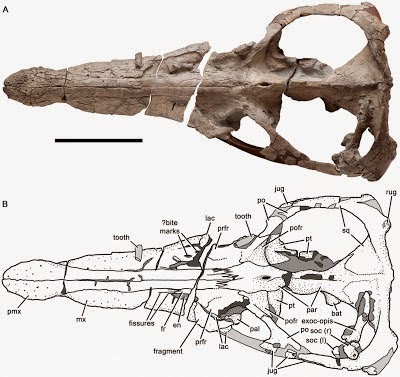The Hupehsuchians are a group of Marine Reptiles known only from the
Early Triassic of Hubei Province, China. Their origins and relationships are
obscure, though it has been suggested that they might be related to
Ichthyosaurs. They typically have heavily ossified, dense bones on their trunk
(which is usually an adaptation to diving or bottom feeding in Marine Reptiles
and Mammals, as it helps to reduce buoyancy), combined with inflexible bodies
and elongate, flattened snouts.
In a paper published in the journal PLoS One on 17 December 2014, Xiao-hong
Chen of the Wuhan Centre of the China Geological Survey, Ryosuke Motani of the
Department of Earth and Planetary Sciences at the University of CaliforniaDavis, Long Cheng, also of the Wuhan Centre of the China Geological Survey, Da-yong
Jiang of the Laboratory of Orogenic Belt and Crustal Evolution at Peking University and Olivier Rieppel of
the Center of Integrative Research at The Field Museum in Chicago, describe a
new species of Hupehsuchian from the Early Triassic Jialingjiang Formation at
Yangping in Yuan’an County in Hubei Province.
The new species is named Eohupehsuchus
brevicollis, where ‘Eohupehsuchus’
means ‘dawn-Hubei-Crocodile’ and ‘brevicollis’
means ‘short neck’. It is a small Hupehsuchian with an estimated length of
about 40 cm, though much of the tail is missing giving it a preserved length of
23.6 cm. It has an elongated flattened snout, lacking any teeth, and the
shortest known neck of any Hupehsuchian, with only six cervical vertebrae.
Eohupehsuchus
brevicollis. Scale bar I cm. Chen et al. (2014).
As a new species notably smaller than other members of the group,
which are also known from the same area, it was natural to consider the
possibility that Eohupehsuchus
brevicollis is in fact a juvenile of another species. However the long
bones (limb bones) of the specimen appear well ossified, which is generally
taen as a sign of maturity (these bones ossify slowly as an animal grows, and
once fully ossified have little potential for further growth), and the number
of neck vertebrae is smaller than any other known member of the growth, which,
since vertebrates do not usually grow new vertebrae as they grow, strongly
implies that it is a new species.
Pectoral and pelvic regions of Eohupehsuchus brevicollis. (A) Pectoral region. (B) Pelvic region.
Symbols: Cl, clavicle; Co,coracoid; F, femur; Fi, fibula; H, humerus; h#, hemal
spine; Icl, interclavicle; Il, ilium; Is, ischium; n#, neural spine; Pb, pubis;
r#, rib; Sc, scapula; v# vertebralcentrum. Colors: blue, vertebral centra;
brown, neural spine first segment; green, neural spine second segment; light
blue, rib; light green, limb elements;light purple, hemal spines; light yellow,
girdle elements; orange, gastral elements; pink, dermal armour second layer;
red, dermal armour first layer; red-purple,dermal armour third layer; yellow,
parapophysis. Scale bars are 1 cm long. Chen et al. (2014).
The tip of the left forelimb of Eohupehsuchus
brevicollis appears to have been lost before burial, probably implying
predation or scavenging. Since there are no other signs of scavenging, Chen et al. favour predation as an
explanation (i.e. the tip of the limb was bitten off before the animal died),
though there is no sign of any healing, which would suggest that the injury
occurred shortly before death, though it is unlikely to have been fatal in
itself.
Forelimbs of Eohupehsuchus
brevicollis. Symbols: bb, broken bones that are kinked from damage; bp,
broken bone pieces thatare dislocated; i, intermedium; i–v, metacarpal; H,
humerus, R, radius; r, radiale; U, ulna; u, ulnare; 1–5, distal carpal. Scales
are 1 cm long. Chen et al. (2014).
See also…
The Pliosaurs were Mesozoic marine reptiles that arose in the Late
Triassic or Early Jurassic and persisted till the Late Cretaceous. They
were related to modern lizards and snakes, but were fully aquatic, the
largest species reaching 15 m in length. All species seem to have been
strict carnivores, and at least one species gave birth to live young.
Plesiosaurs are thought to have been fully aquatic from their first
appearance; they are...
Placodonts were a group of Sauropterygian Reptiles (a group related to
Snakes and Lizards that includes the better known Pliosaurs and
Plesiosaurs which survived to the end of the Mesozoic) from the mid-to
late Triassic. They were large animals, ranging one to...
The Ichthyosaurs were a group of marine tetrapods that resembled
dolphins. They appear in the fossil record in the mid-Triassic about 245
million years ago, and survive till the mid-Cretaceous, about 90
million years ago. During the Jurassic they appear to have been the top
marine predators, but in the Cretaceous they were...
Follow Sciency Thoughts on Facebook.






